
 HMS WISHART
HMS WISHART
Leading Seaman Ronald W.W. Rendle JX167874
1919 - 2017
|
I
first met Ron Rendle in Derby at the annual reunion of the V & W
Destroyer Association in May 2010. Clifford Fairweather, a veteran of
HMS Westcott and Chairman of
the Association, told me Ron had been torpedoed three times. Ron
indignantly corrected him - it was only twice! Ron suffered from cancer and was kept alive by a cocktail of chemicals injected once a year but he outlived his oncologist and was 98 when he died on the 23 December 2017. There can not be many heads of local authority housing departments who ran a night club in retirement and liked to gamble at their local casino. He was both modest and amusing and everybody liked him. I published an account of what it was like to serve in the cramped quarters of a V & W Class destroyer during World War II and half the print run of both editions were bought by the men who served in these ships - or their children and grand children. This led to my setting up this website to keep the memory of the V & Ws and the men who served in them alive after they had all "crossed the bar". The Association was dissolved in May 2017 but you can read Ron Rendle's story below and listen to him tell his story in an interview I recorded at Warwick in 2013. Bill Forster
|
The Armed Merchant Cruiser HMS Patroclus
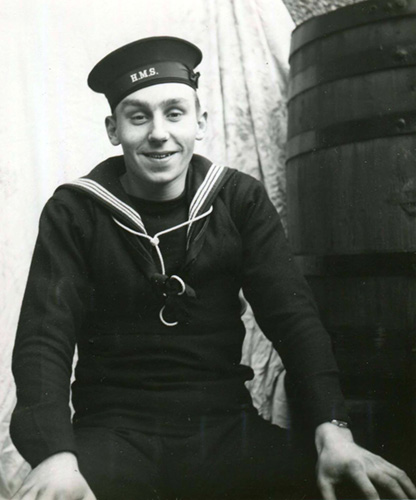 |
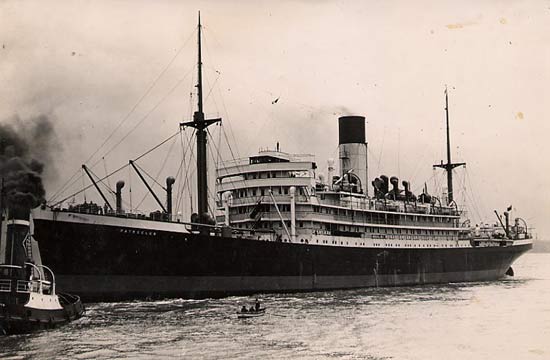 Two
studio photographs of Ron Rendle shortly after joining the Navy in 1939
and a photograph of his first ship, the Armed Merchant Cruiser (AMC)
HMS Patroclus torpedoed by U-99 on 4 November 1940
|
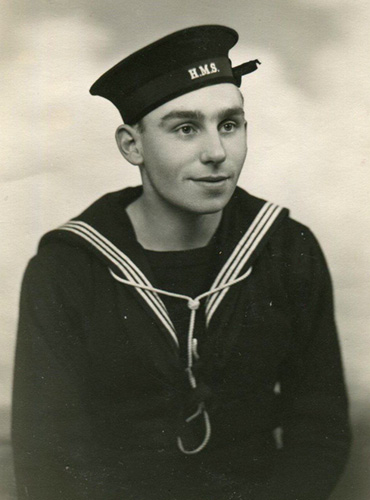 |
These two recently discovered portraits of Ron were lent by the family. He was drafted to his first ship,
the Armed Merchant Cruiser (AMC), HMS Patroclus at Portsmouth, on 13 January 1940. She was commanded by Capt G.C. Wynter RN. HMS Patroclus
was sent to the Med and brought back refugees and troops who had escaped to the South of France after Dunkirk and reached Gibraltar. Ron celebrated his 21st
birthday at Casablanca. HMS Patroclus
patrolled the Atlantic looking for blockade runners. She boarded a
suspicous Norwegian merchant ship and escorted her to Scapa Flow. After the merchant ship was allowed to leave Scapa she was torpedoed by German U-Boat, the crew
were saved and the only life lost was that of the ship's dog.
On 3 November 1940 Patroclus was escorting the 6,000 ton steamer SS Casanare and HMS Laurentic
when they encountered U-99 commanded by Otto Kretschmer. Kretschmer sank more
allied tonnage than any U-boat commander. The Patroclus was like a floating block of flats with its hull buoyed up by empty oil
barrels. U-99 sank all three ships but it took six torpedoes to sink
HMS Patroclus.
The first torpedo struck two minutes after midnight and Patroclus finally broke in two and sank at 05.25 on the 4th November. Ron
Rendle jumped into the water after the fourth torpedo struck, went down, surfaced and was violently
sick. He was picked up later that morning by the destroyer HMS Achates, was given some rum to drink, lent a hammock and slept for twelve hours.
The complete sequence of events when U-99 sank these three ships plus the oil tanker Scottish Maiden is detailed in the Kriegstagebuch (War Diary) of U-99 from the 22 October to the 8 November which has been translated by Capt. Jerry Mason USN (Ret) and published with the tracking plates on uboatarchive.net
Kretschmer was captured in March 1941 by Captain Donald G.F.W. Macintyre of HMS Walker as described in his book
U-Boat Killer (London: Wiedenfield and Nicolson, 1956) and in The Golden Horseshoe: The Wartime Career of Otto Kreschmer, U-Boat Ace by Terence Robertson, a book read and admired by Ron Rendle. He was photographed leaving HMS Walker after his capture.
After two weeks survivors leave Ron was drafted to HMS Dunluce Castle, an accommodation (depot) ship at Scapa Flow in Orkney. Most of the survivors of the Patroclus were
sent there. It was really an opportunity to recover from the trauma of
the sinking. Ron as a clerk in local government was given an office job
and quite liked his three months at Scapa. From 21 May to 20 August
1941 Ron trained to be a torpedo man at HMS St Vincent, a shore establishment in Gosport, Portsmouth.
HMS Wishart
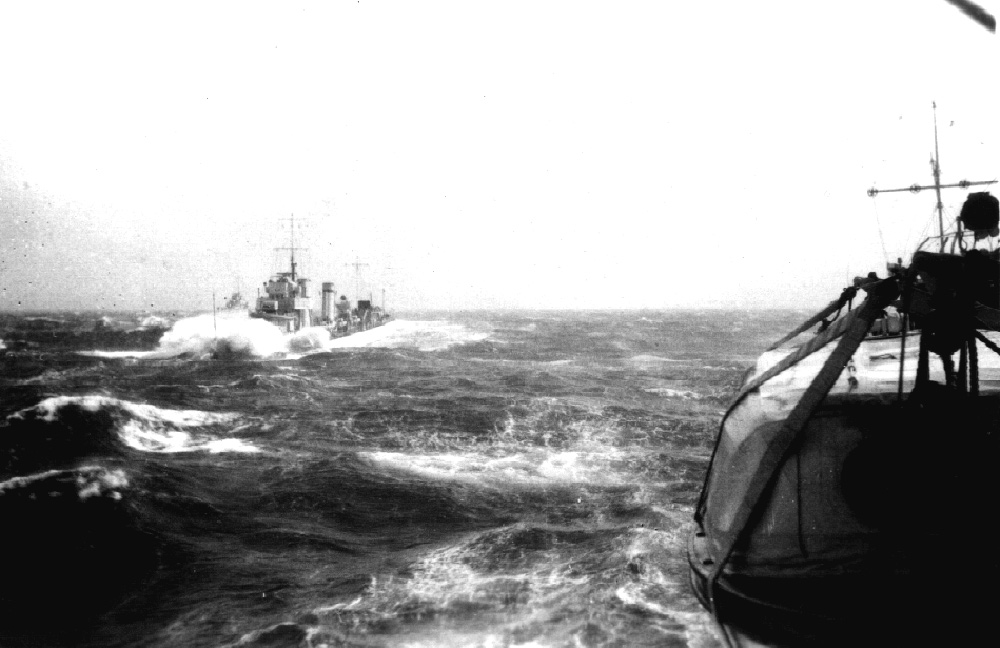
The V & W's were built as "torpedo boat destroyers" (TBD) and
Ron was "on the tubes" but never fired a torpedo, not even in practice.
The six torpedo men
were really electricians; two on the torpedo tubes and four on the depth
charges.The depth charges were rolled off the rails at the stern or thrown from
midships. The three torpedo men
on the left are lounging in front of the triple torpedo tubes on HMS Wishart. On
one memorable occasion the skipper gave instructions that a depth
charge should be dropped when the Asdic showed a shoal of fish and
enough floated to the surface to feed the entire ship's company.
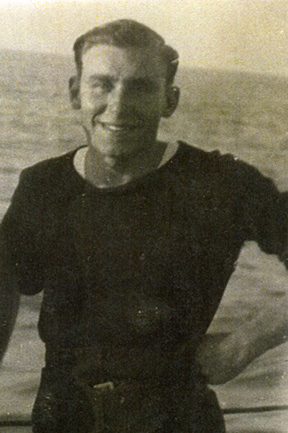 |
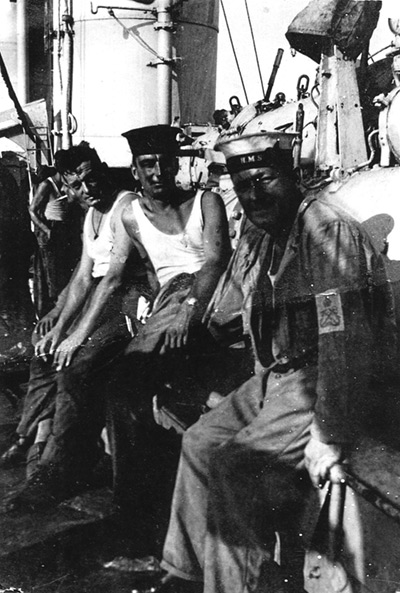 |
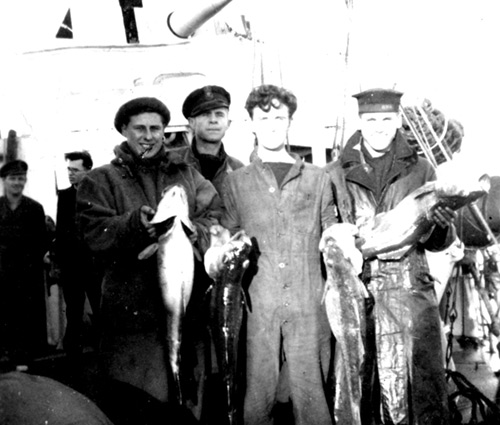 |
Sixteen young Hostilities Only (HO) ratings joined Wishart in February 1942 while she was based at Gibraltar. They went from Greenock to Gibraltar on the former passenger liner, Llanstephen Castle, which was requisitioned for use as a troop carrier and stayed on the depot ship, Maidstone, until the Wishart
came in. They joined on the same day, shared the cramped living
quarters on the mess decks, drank together when back in Gib and some
are still friends today. They included three members of the V & W
Destroyer Association, Doug Lochhead, Derek Shepherd and Colin Seaman.
The men believed that if the Padre joined a ship she was sure to be attacked. Ron was "not pleased to see him" when he joined Wishart
and, sure enough, they were bombed. There were too many incidents to describe but Ron saw an ammo ship blown up on one
convoy, looked like "a ball of sun", it just vanished. On the 7 November 1942 Wishart towed the USS Thomas Stone into Algiers after she was torpedoed and they were paid prize money. They went ashore at
Algiers after the landings in North Africa and "had good
times". He
saw a "banana boat aircraft
carrier" come out of Algiers with his cousin Clifford on her. Ron was
shocked when heard much later that his cousin was killed with most of the crew when she sunk in the Atlantic.
Ron's best friend on Wishart was AB Arthur Crosby-Clarke who worked for Barclays Bank in Bournemouth before the war and whose regular Watch was "on the Wheel'. Cdr Scott was keen on hockey and saw the ship's hockey team beat the writers at Gib, the best team on the Rock. Scott liked Ron because he was one of the strongest players in the hockey team and when Wishart docked for repairs at Gib in May 1942 he sent Ron and Crosby-Clark on a short break at the Rest Camp in the Governor's Cottage near the Europa Point light house. Ron served in Wishart until the 13 December 1942 but has no recollection of rescuing survivors from HMS Blean which sank two days earlier. Crosby-Clarke stayed on until Wishart was mothballed in January 1945. They never met again but Ron always hoped to find out what happened to him.
Ron was relieved at Gib and sent back to Britain to qualify as a Leading Torpedoman at HMS Vernon,
the Torpedo School, at Gunwharf, Portsmouth. It had been bombed out and
taken over the former girls school, Rodean, which made him "an
old boy of Rodean". Ron spent the next four months at shore bases for
Coastal Forces: at HMS Attack in Portland from 19 - 25 May, HMS Hornet near the Haslar Gunboat Yard at Portsmouth from 26 May - 14 June and HMS Midge at Great Yarmouth from the 9 August - 14 September 1943. HMS Midge
was one of the major coastal force bases on the East Coast and several
flotillas of MTBs were based there. The details are recorded in his
service record but Ron remembers very little about his time at these
Coastal Forces shore bases.
HMS Bickerton, an American built Captain Class destroyer commanded by Capt Donald G.F.W. Macintyre, RN
On
15 September Ron was sent to Halifax, Nova Scotia, on a troop carrier and
from there halfway across Canada by train before heading to New York
and Boston where HMS Bickerton, a diesel-electric Captain Class destroyer, was being built. He joined the Bickerton
on 5 November 1943. After
commissioning Bickerton left for Halifax, Nova Scotia, on a
shakedown cruise before returning to Boston where Ron had a girl friend from Reading, Pearl Galatun, who called him "Aces". They headed south to Norfolk Virginia which Ron
did not like so Pearl and her Mother paid him a visit to cheer him up.
On her way to Britain the Bickerton spent the morning of Christmas Day in Bermuda and then continued to Liverpool. The skipper "was very fond of his alcohol" and his "No 1" more or less ran the ship on the way over. The wiring on US ships was different from ships in the RN and when Ron made a mistake testing a circuit he was temporarily blinded and hospitalised at HMS Pegasus, Belfast, from 24 February to 12 March 1944.
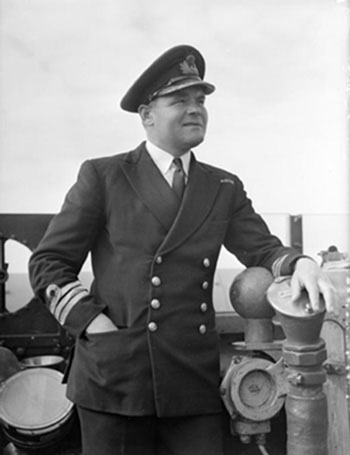 Capt Donald G.F.W. Macintyre,
RN, a brilliant u-boat hunter on Atlantic convoys, took over as CO of Bickerton. He was "an absolute tyrant but the best skipper I ever had". He was the first wartime CO of HMS Venomous (as described in A Hard Fought Ship, 2017) and in March 1941 was CO of HMS Walker when she sunk U-99 and captured Otto Kretschmer, who had sunk HMS Patroclus. When Bickerton sunk U-765
on 5 May 1944 Ron thought the survivors were "much the same as us, mixed in, had good jokes and we got on well".
Capt Donald G.F.W. Macintyre,
RN, a brilliant u-boat hunter on Atlantic convoys, took over as CO of Bickerton. He was "an absolute tyrant but the best skipper I ever had". He was the first wartime CO of HMS Venomous (as described in A Hard Fought Ship, 2017) and in March 1941 was CO of HMS Walker when she sunk U-99 and captured Otto Kretschmer, who had sunk HMS Patroclus. When Bickerton sunk U-765
on 5 May 1944 Ron thought the survivors were "much the same as us, mixed in, had good jokes and we got on well".
Ron photographed the frigate HMS Mourne (K 261) blowing up after she was hit by a GNAT torpedo from U-767 on the 15 June. He got his film from "an old school pal", Robert Patience, who worked at
the Selo factory in Brentwood, part of Ilford. Bob was the tail gunner on a bombing raid
over Hamburg in 1943, part of Operation Gomorrah to destroy Germany's second largest city. Their plane was badly shot up and the entire crew
invalided out. Ron soon had a good business going, selling film
to
his shipmates, taking their photographs, developing the
film and making prints. Bickerton
sunk U-269 while patrolling the entrance to the Channel during the D-Day landings.
Torpedoed!
22 August 1944
When Macintyre heard that Ron had a
camera he transferred him from his action station with the depth
charges at the stern (there were no torpedos on Bickerton) to the
Bridge where he would be on hand to photograph the
sinking of his next u-boat.
In August 1944 Bickerton was sent Scapa Flow to escort two escort carriers, HMS Nabob and Trumpeter, part of Convoy JW.59, to Tromso (Operation Goodwood) in Norway to attack the Tirpitz. On the 22 August HMS Nabob was hit by an acoustic torpedo, a GNAT, fired by U-354 and soon afterwards Bickerton
was hit in the stern and all of Ron's friends at his former action
station were killed. Macintyre knew the danger of a
GNAT zeroing in on the acoustic noise of a ship's propellors and had
ordered a
"cat" to be streamed from the stern. This device vibrated like the screws of a destroyer and lured acoustic torpedoes
away from the stern of the ship. They were too late getting it out
and the man sent from the bridge to speed things up was killed along
with all the men in the depth charge team.
Macintyre's official Report of Proceedings in the National Archives (ADM 358/3070) is unusually vivid and worth quoting from here:
"At 1725 while still in process of streaming the CAT which had just been heard beginning to function, Bickerton was struck by a torpedo, presumably acoustic, right aft. The ship shuddered violently while a huge plume of water in which could be seen depth-charges and bodies rose to a great height over the stern, and the ship then came to a stand-still. The CEA smoke apparatus evidently burst and choking fumes of chloro-sulphonic smoke were blown through the ship by the ventilating blowers aft making it impossible to remain anywhere except on the windward side of the upper deck without being gassed.
At the same time the starbord steam siren, a particularly noisy fog horn type of siren of American pattern, jammed full on making it impossible for even the loudest shouts into the ear of a neighbour from being heard. This was particularly unfortunate as a number of the ship's company began to panic and carley floats were launched and some ratings followed them overboard. The whaler was also turned out and in spite of eloquent gestures of officers, which was all they could do in the appalling noise of the siren, this boat was lowered and filled dangerously full.
Eventually, however, the Engineer Officer was found wandering about the upper deck and he was sent to get steam turned off the siren. It is not certain whether or not it was due to any action on the part of the Engineer Officer or whether it was simply that steam pressure failed, but shortly after this the siren stopped. In the blessed silence that followed, it was possible to regain control of the situation. The would be deserters were brought back on board many of them covered in oil fuel and all wet through and shivering with cold, thus no doubt earning their just reward for allowing themselves to panic.
It
was possible now also to receive reports on the extent of the damage.
The setting in motion of the damage control organisation had devolved
on Petty Officer Samuel Taylor, official number D/KX.81459, as the
after repair party had been more or less wiped out by the explosion and
it was now found that the Engineer Officer, Chief ERA and Chief Stoker
had abandoned ship without orders. Stoker Petty Officer Taylor,
however, although it seemed likely at the time that the ship might not
float for long, had without orders gone below and made an examination
of the situation. He was thus able to report that the aft engine room
bulkhead was holding well and that, in fact, the machinery spaces were
undamaged. He volunteered to take a party down to raise steam again and
to get the pumps going and shore up the engine room bulkhead.
Permission was granted, but shortly afterwards I ordered all hands on
to the upper deck again as it was obvious that it would not be possible
with the resources to hand to tow the ship to harbour and that she
would have to be sunk to allow all ships to concentrate on the
protection of Nabob, whose Commanding Officer had reported that he hoped to get underway again shortly on one engine."
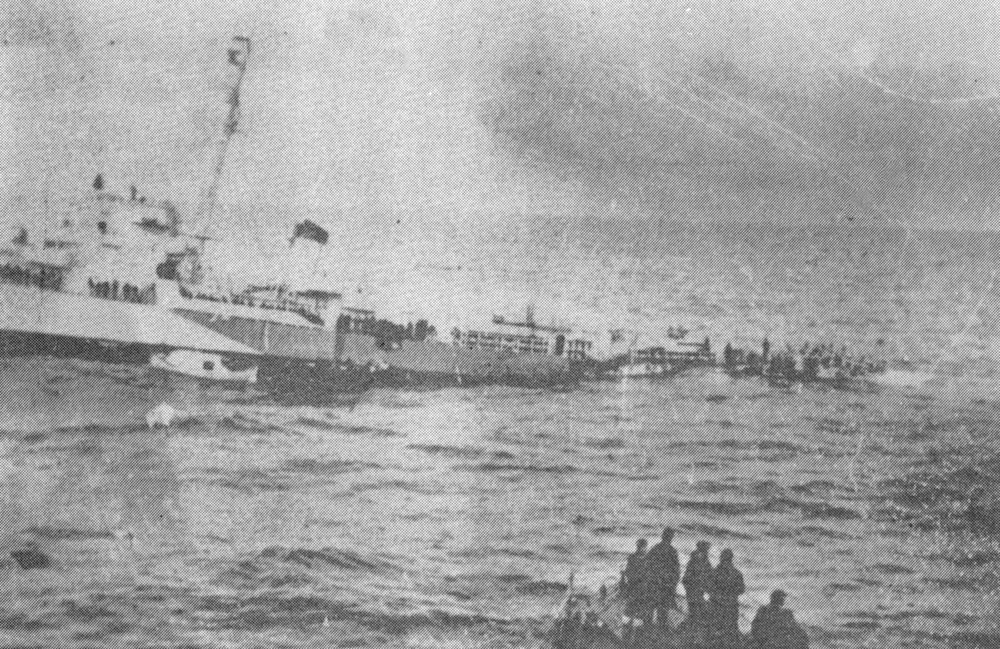
HMS Bickerton sinking by the stern while HMS Aylmer stands by to rescue survivors - photographed from HMS Kempthorne
A poor image scanned from a secondary copy - not the original
Donald Macintyre described what happened in Chapter 12 of his autobiography, U-Boat Killer
(1956), where Ron Rendle gets a brief mention: "A Leading Seaman Rendle
and an Electrical Artificer Robinson both set good examples, I
remember." The
money Ron made from photography was in the ship's safe and
went down with the ship along with all of his photographs.
The survivors from the two escort carriers, the Nahob and the Bickerton, were rescued by HMS Kempthorne and HMS Aylmer. Rescuing survivors from the carrier HMS Nabob was
given priority and Macintyre told Ron to stay aboard until a
launch was sent (one did not last long in Arctic waters). Bickerton had to be sunk by a Fleet Destroyer, HMS Vigilant. The survivors from the Bickerton were transferred to the Kempthorne and landed at Scapa Flow. HMS Nabob was escorted to the Clyde at an average 10 knots by HMS Aylmer, HMS Bligh, HMS Kempthorne and HMS Keats. HMS Nabob began her life as the merchant ship Edisto but was converted into a Ruler Class Aircraft Carrier. Her story is told on "For Posterity's Sake", a
Royal Canadian Navy historical project. She was torpedoed less
than a year after commissioniing but had a long "after life":
"HMS Nabob was
deemed not worth repairing, towed to Rosyth, beached and abandoned.
Paid off on 30 Sep 1944, retained in nominal reserve, but was
cannibalized for spare parts for sister ships. On 16 Mar 1946 she was
returned to the US Navy and stricken. Sold for scrap in Mar 1947 in the
Netherlands. However, she was resold to the Norddeutscher Lloyd,
converted to the German motor merchant Nabob until 1952 and used as a civilian training vessel for the post war German merchant service. In 1968 renamed Glory and registered in Panama. In Dec 1977 sold for scrap in Taiwan."
Ron Rendle met his wife Elaine Campbell in Belfast and they got married there in 1944 while he was on survivor's leave. Ron spent almost three months at HMS Victory and HMS Vernon before being drafted to HMS Lanka, the shore base in Ceylon, on 13 December 1944 to await a posting to another ship. HMS Lanka
occupied the site of St Josephs College, Colombo. Ron was given
the job of organising the guard.
He never received another posting and
on 2 October 1945 he returned to Britain on the Town Class destroyer, HMS Rotherham.
He really liked the ship's company and they wanted him to stay on. They
had fought in the Pacific war against Japan, been attacked twice by Kamikaze pilots but last minute evasive
action by the CO saved the ship. On 4 September Rotherham was the
first RN warship to enter Singapore after the dropping of the Atom bomb
and the surrender of Japan. The
crew were shocked by the condition of the POWs in the city. Ron returned to England in the Rotherham on 12 November 1945.
After the war was over
Ron Rendle was released from the Navy on 31 January 1946 and returned to his prewar career in local government. He also went into business running the Barn nightclub in Braintree with his old
friend, Bob Patience, who had supplied him with film when he was in HMS Bickerton. Bob started the Ranch House in the 1950s and the Barns in the 1960s. Bob would not allow proceedings to get under way
until Ron arrived from daytime job in local government when he would announce "now that Ronald Walter
William Rendle is here we can start". All
the stars of the day played at the Barns and Ron knew them all.
Ron Rendle retired as Housing Chief at Tonbridge and Malling Council in Kent on a full pension at 55 when local government was reorganised in 1974. Until 2016 he continued to drive, visited the casino in Southend-on-Sea every other week and never missed an annual reunion of the V & W Destroyer Association.
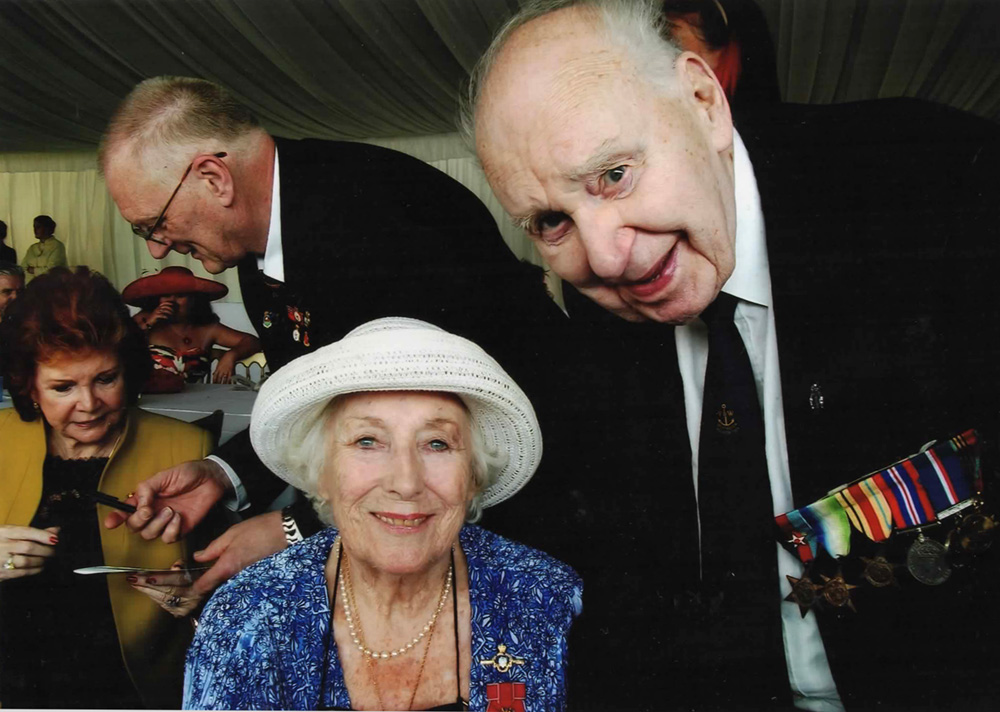
He was a regular at the Buckingham Palace Garden Parties for veterans hosted by the Queen and Prince Philip who served in the V & W Class Leader HMS Wallace and always made a beeline for the V & W veterans. Amongst those he met at the garden parties was Vera Lynn (1917-2020) who like Ron was born in East Ham. Despite being a keen photographer he has no photographs of himself in naval uniform - but a few were found after his death. All of those taken on HMS Bickerton were lost when she was torpedoed. He never forgot the names of his shipmates at the stern of HMS Bickerton who were killed and could see them clearly in his mind's eye for the rest of his life. Ron had four children, ten grand children and eighteen great grandchildren but admitted to not being able to remember all their names.
***************
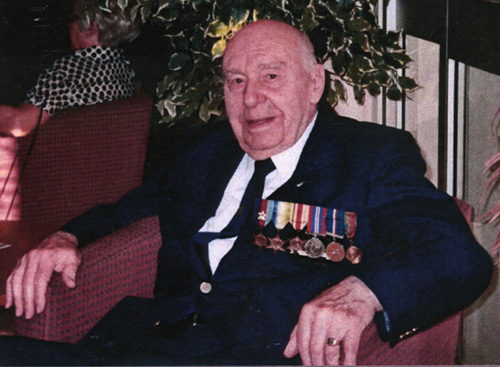 Ron's
funeral on Thursday 8th February 2018 at the Three Counties Crematorium
in Halstead Road, Bocking End, Braintree, was attended by several
members of the V & W Destroyer Association as well as his
sons, daughters and grand children and the many friends he made during
his long life.
Ron's
funeral on Thursday 8th February 2018 at the Three Counties Crematorium
in Halstead Road, Bocking End, Braintree, was attended by several
members of the V & W Destroyer Association as well as his
sons, daughters and grand children and the many friends he made during
his long life.
The order of service was adorned with horses racing for the finishing line. Ron "liked a flutter" and would arrive for work with the Racing Times under his arm and would spend his first half hour studying form and reaching decisions on which horses to back. His secretary knew he was not to be disturbed until this had been done. He was liked and respected by his staff and got on well with "the members" which is so important in getting things done in local government.
Ron's eldest son Dereck knew his father well and gave us an insight into his life and character at the funeral service. He described Ron's love of sport, especially hockey and tennis which he played in Ceylon. He was a county class standard table tennis player, a left hander who played Johnny Leach, the world singles champion in 1949. Dereck described his liking for the alternative world of running a successful night club with his old friend Bob Patience and the temptation this provided to over indulge. The two of them decided the solution was to switch to Vermouth and soda and their favourite tipple became Noilly Prat - but too often drank by the bottle instead of the glass.
The
members of the V & W Destroyer Association will always remember the
ladies who accompanied him to the annual reunions and anticipating his
every need waited on him hand and foot. They were close friends, not
carers and Ron was very fond of them and they of him.
It
is unusual for a rating in a Royal Navy warship to have an obituary
published in a national newspaper but Ron was an unusual man
The Daily Telegraph published an obituary of Ron Rendle on the 8 March 2018
He is greatly missed by all of us who knew him.
Bill recorded an interview with Ron
Rendle at the Reunion of the V & W Association at Warwick on 20
April 2013
Click on the link to listen to Ron describe his wartime service in HMS Wishart
be patient - it takes a couple of
minutes before the file opens and Ron starts speaking
The IWM made their own recorded interview which can also be heard online